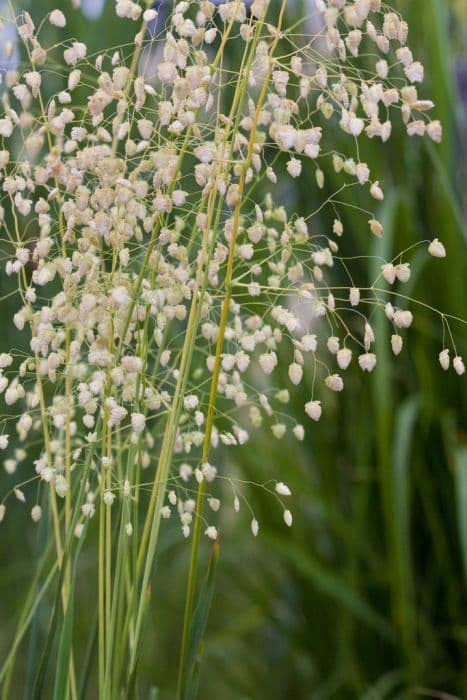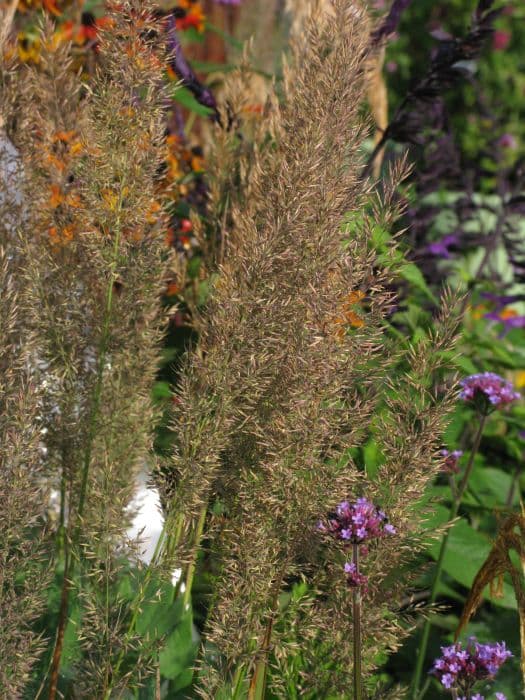Switchgrass Panicum virgatum 'Rotstrahlbusch'











ABOUT
The plant commonly known as Rotstrahlbusch switchgrass is recognized for its striking foliage and ornamental value. It boasts leaves that have a reddish hue, particularly pronounced during the warmer months. As the season transitions to fall, the color of the leaves deepens to a rich, burgundy red, providing a vibrant display. The plant has a clumping growth habit, creating a dense and bushy appearance. Throughout summer and into fall, it produces wispy, airy flower panicles that rise above the foliage, lending a delicate texture. These flowers often have a purplish-pink tinge, which adds to the visual interest of the plant. As the plant matures through the seasons, it develops a notable color change in its foliage and continues to contribute to its surroundings with its changing aesthetic. This switchgrass variety is a popular choice in gardens and landscaping for its dynamic color and form.
About this plant
 Names
NamesFamily
Poaceae
Synonyms
Switchgrass, Red Switch Grass, Tall Prairie Grass, Wand Panic Grass, Switch Cane, Blackbent, Wild Redtop, Thatch Grass
Common names
Panicum virgatum 'Rotstrahlbusch'.
 Toxicity
ToxicityTo humans
The common name for Panicum virgatum 'Rotstrahlbusch' is Switchgrass. Switchgrass is not known to be toxic to humans. It does not contain any known toxic compounds that would cause poisoning if ingested. Therefore, there are generally no symptoms of poisoning or adverse health consequences expected from ingesting any part of the Switchgrass plant.
To pets
Switchgrass is the common name for Panicum virgatum 'Rotstrahlbusch'. It is generally considered non-toxic to pets. There are no significant toxic principles in this plant that would cause poisoning in animals if they were to ingest parts of it. Consequently, no symptoms of poisoning or harmful consequences are typically associated with the ingestion of Switchgrass by pets.
 Characteristics
CharacteristicsLife cycle
Perennials
Foliage type
Deciduous
Color of leaves
Green
Flower color
Pink
Height
3-4 feet (0.9-1.2 meters)
Spread
2-3 feet (0.6-0.9 meters)
Plant type
Grass
Hardiness zones
4
Native area
North America
Benefits
 General Benefits
General Benefits- Ornamental Appeal: Switchgrass 'Rotstrahlbusch' adds visual interest to gardens with its upright form, reddish-pink flowering panicles, and vibrant fall foliage.
- Drought Tolerance: Once established, it is highly tolerant of drought conditions, reducing the need for frequent watering.
- Low Maintenance: It requires minimal care beyond initial planting and occasional cutting back, making it an easy option for gardeners of all levels.
- Erosion Control: The robust root system of switchgrass helps stabilize soil and prevent erosion on slopes or in areas prone to soil loss.
- Habitat for Wildlife: It provides shelter and food for birds and insects, supporting local biodiversity.
- Tolerance of Poor Soils: Switchgrass 'Rotstrahlbusch' can thrive in a variety of soil conditions, including poor quality and infertile soils.
- Seasonal Interest: It offers year-round interest, from its green shoots in spring to golden hues in fall and tan stems in winter.
- Flexibility in Landscaping: It can be used in a range of landscape designs, from naturalized areas to formal garden beds.
- Privacy and Screening: When planted in groups, it can create a natural screen or privacy barrier in the landscape.
- Support for Ecosystem Services: It plays a role in capturing carbon and supporting overall ecosystem health.
 Medical Properties
Medical PropertiesThis plant is not used for medical purposes.
 Air-purifying Qualities
Air-purifying QualitiesThis plant is not specifically known for air purifying qualities.
 Other Uses
Other Uses- Switchgrass 'Rotstrahlbusch' can be used as a natural dye source, providing a range of subtle colors to fabrics, depending on the mordant used.
- The dense foliage makes it an excellent choice for creating privacy screens or living fences in landscapes.
- Due to its robust growth, it can be used for erosion control on hillsides and in areas prone to soil degradation.
- It can serve as a biofuel crop, offering an alternative renewable energy source when processed into biomass pellets or liquid biofuel.
- Its tall and sturdy stems can be used in basketry or as natural stakes for supporting other plants in the garden.
- The dry stems of Switchgrass 'Rotstrahlbusch' can be bundled and used as an eco-friendly garden mulch to suppress weeds and retain soil moisture.
- It can be planted in rain gardens where its roots help in filtering pollutants and improving water quality.
- Switchgrass 'Rotstrahlbusch' can be used as a substrate in mushroom cultivation, supporting the growth of certain edible and medicinal fungi.
- It may be considered for use in phytoremediation strategies, where its deep rooting system can help to stabilize and remove toxins from contaminated soils.
- The ornamental seed heads can be utilized in floral arrangements and crafts, adding rustic charm and texture.
Interesting Facts
 Feng Shui
Feng ShuiThe plant Panicum virgatum, commonly known as switchgrass, is not specifically used in Feng Shui practice.
 Zodiac Sign Compitability
Zodiac Sign CompitabilitySwitchgrass is not used in astrology practice.
 Plant Symbolism
Plant Symbolism- Adaptability: The switchgrass is known for its adaptability, able to thrive in a range of soil conditions and climates, symbolizing the ability to adjust and flourish in various life situations.
- Resilience: With its deep root system, switchgrass represents resilience and the capacity to withstand challenges and recover from adversity.
- Growth: As a plant that can reach considerable heights, switchgrass embodies the concept of growth, both physically and metaphorically, suggesting progress and personal development.
- Balance: The switchgrass contributes to soil health and erosion control, making it a symbol of ecological balance and environmental stability.
 Water
WaterSwitchgrass, as Panicum virgatum 'Rotstrahlbusch' is commonly known, is a hardy plant requiring moderate watering. During the growing season, water the grass once a week with about 1-2 gallons per plant, ensuring the soil is moist but not waterlogged. When established, it is quite drought-tolerant, thus in cooler seasons or during rainy periods, reduce watering frequency. It's imperative to avoid overwatering, as standing water can lead to root rot. For young plants, consistent moisture is crucial to help establish a strong root system.
 Light
LightSwitchgrass thrives in full sun conditions, so place it in an area where it can receive at least six hours of direct sunlight daily. This grass can tolerate some partial shade, but its best color and form are achieved in full sunlight. An open spot without the shade of larger trees or buildings is ideal for the robust growth of Switchgrass.
 Temperature
TemperatureSwitchgrass is incredibly resilient and can withstand a wide range of temperatures. It can survive in temperatures as low as -20°F and can manage high summer temperatures well above 90°F. An ideal temperature range for Switchgrass growth would be between 70°F and 90°F. Insulating the base with mulch in winter can protect the roots in colder climates.
 Pruning
PruningPruning Switchgrass is essential to maintain its shape and encourage new growth. It's best to cut back the foliage to about 4 inches in late winter or early spring before new shoots appear. This annual pruning keeps the grass looking tidy and allows for a fresh start each growing season. Dead or damaged stems can be removed as needed throughout the year.
 Cleaning
CleaningAs needed
 Soil
SoilSwitchgrass 'Rotstrahlbusch' thrives in a soil mix that is well-draining and rich in organic matter, with a pH range of 5.5 to 7.0. A combination of loamy soil, peat, and sand works well to support its growth.
 Repotting
RepottingSwitchgrass 'Rotstrahlbusch' typically does not require frequent repotting as it's a perennial grass meant for outdoor growth; repotting may only be necessary if it outgrows its container or every 3-4 years.
 Humidity & Misting
Humidity & MistingSwitchgrass 'Rotstrahlbusch' is tolerant of a wide range of humidity levels and does not have specific humidity requirements, making it an adaptable plant for varying environmental conditions.
 Suitable locations
Suitable locationsIndoor
Provide full sun and well-draining soil for Switchgrass 'Rotstrahlbusch'.
Outdoor
Plant in full sun with well-draining soil; water regularly for Switchgrass 'Rotstrahlbusch'.
Hardiness zone
4-9 USDA
 Life cycle
Life cyclePanicum virgatum 'Rotstrahlbusch', commonly known as Switchgrass, initiates its life cycle with seed germination, which typically takes place in the spring when soil temperatures are warm enough. After germination, the seedlings establish themselves and begin to grow vertically and horizontally through vigorous root systems. Throughout the growing season, switchgrass develops tall and sturdy stems with linear leaves, and by mid-summer, the plant begins to form airy panicles of reddish-purple flowers, giving it ornamental value. Following pollination, usually by wind, the flowers mature into small seeds by late summer or early fall. With the onset of cooler temperatures in autumn, switchgrass foliage transitions to vibrant shades of red and gold, entering a period of dormancy as the plant senesces, though its structure remains intact providing winter interest and habitat for wildlife. Once spring returns, switchgrass reemerges from its perennial root system, completing the life cycle and beginning anew.
 Propogation
PropogationPropogation time
Late Spring-Early Summer
Propogation: Panicum virgatum 'Rotstrahlbusch', commonly known as Switchgrass, is most effectively propagated through division. The best time for propagating Switchgrass by division is in early spring as the plant emerges from dormancy or in late fall after the growing season has concluded. To propagate by division, carefully dig up the plant ensuring a generous amount of root is included with each division. The plant should be divided into clumps with a sharp spade or knife, making sure that each division has several growth buds. The divisions should then be replanted at the same depth they were originally growing, allowing ample space for the new plants to grow. Once planted, water the new divisions thoroughly to help establish them in their new location.









